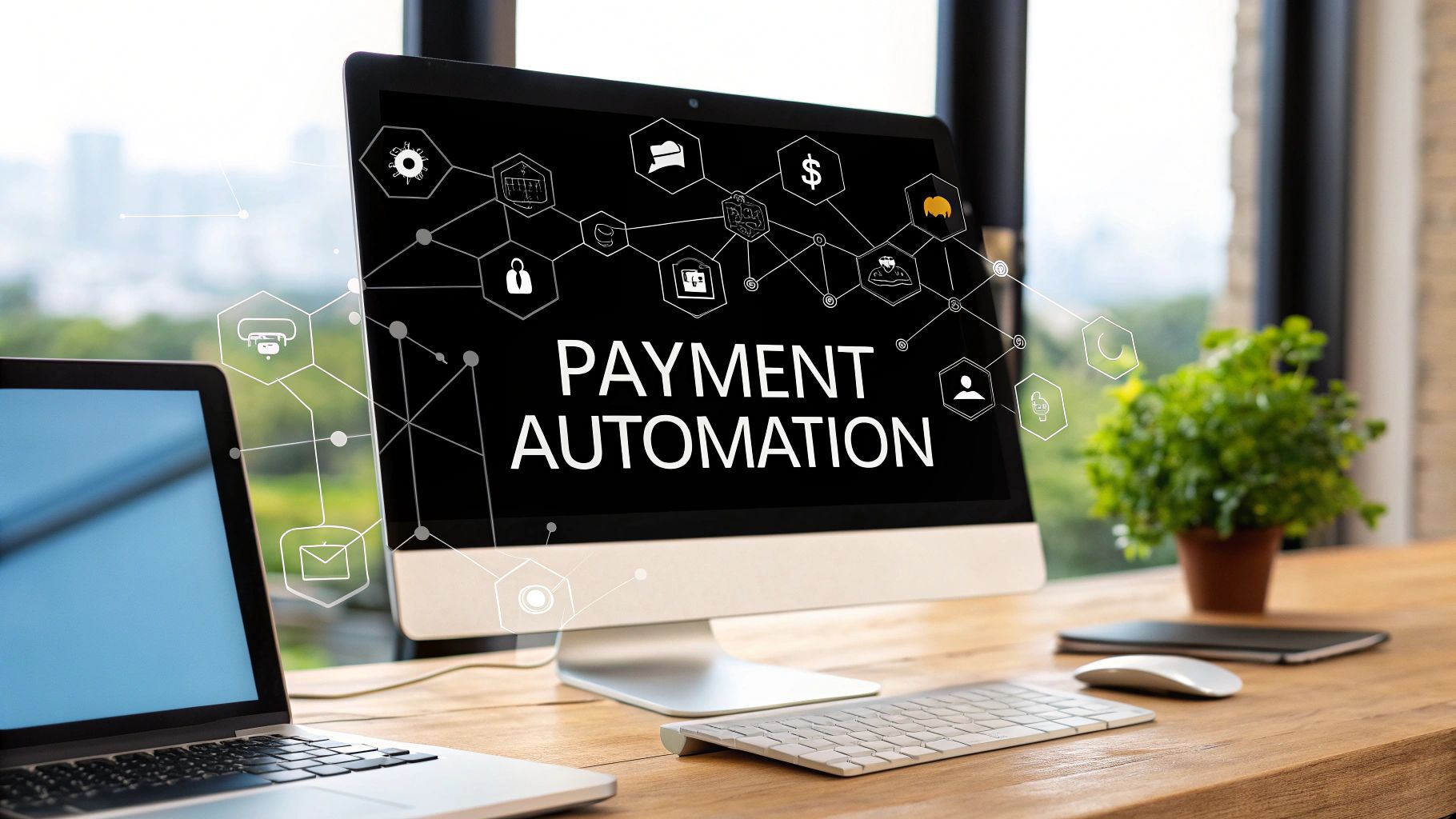The Evolution of Affiliate Payment Automation
Early affiliate programs relied heavily on manual processes. Think spreadsheets, countless emails, and physical checks. While manageable for smaller programs, this quickly became a bottleneck as programs grew. Managing affiliate payments efficiently transformed into a major challenge. This highlighted the need for a better solution – automation.
From Spreadsheets to Software
The initial phase of affiliate payment automation involved simple software solutions. These tools helped track clicks, sales, and commissions, representing a significant improvement over manual calculations. Early platforms, for example, offered automated reporting, simplifying payment calculations and distribution. This freed up program managers to focus on more strategic tasks, like relationship building and program optimization.
Real-Time Reconciliation and Scalability
The next major advancement introduced real-time reconciliation and programmatic payments. Commissions could be calculated and processed instantly, eliminating delays and errors associated with manual systems. This was critical for scaling affiliate programs. In fact, 65% of retailers have reported over 20% revenue growth from affiliate channels, thanks to automated systems for tracking and commissions. Between 2022 and 2024, this shift accelerated as platforms like Rewardful and UpPromote integrated real-time reconciliation, reducing manual processing by 30-50%. Learn more about the impact of these changes on overall affiliate marketing statistics here. By 2025, AI-driven automation is projected to handle 40-60% of payouts in the SaaS and FinTech industries. Even major networks like Amazon Associates, which commands a 46.21% market share, now utilize hybrid models combining automated approvals with human oversight to minimize fraud.
The Rise of AI and the Future of Automation
Today, Artificial Intelligence (AI) is reshaping affiliate payment automation. AI can analyze large datasets to optimize commission structures, forecast payouts, and even detect fraudulent activities. This not only improves efficiency but also enables more strategic decision-making. Imagine a system that automatically adjusts commission rates based on an affiliate's performance, incentivizing top performers and driving better results. This is the potential of AI-driven automation. These advancements pave the way for continuous growth and innovation in the affiliate marketing landscape.
Unlocking Real ROI Through Payment Automation
Affiliate payment automation isn't just about saving time. It's a strategic move to boost your Return on Investment (ROI). Moving beyond manual processes offers tangible benefits that can significantly improve your affiliate program. This translates to increased efficiency, reduced costs, and happier affiliates.
Quantifiable Benefits of Automation
One of the biggest advantages of automation is the reduction in operational costs. Automated systems handle time-consuming tasks like calculating commissions, generating invoices, and processing payments. This frees up your team to focus on more strategic activities, leading to better use of resources and improved overall productivity.
Additionally, automation practically eliminates payment errors. Manual processing can be prone to mistakes, which can damage your reputation and erode affiliate trust. Accurate and timely payments, on the other hand, strengthen affiliate relationships and encourage greater participation, ultimately leading to increased revenue and a thriving affiliate program.
Finally, automation addresses the often overlooked hidden costs of delayed payments. Manual processing frequently leads to payment delays, which can frustrate affiliates and negatively impact their motivation. Automation ensures prompt payments, fostering a positive and productive working relationship.
You might be interested in: How to master affiliate program management
From Pain Points to Solutions
Many program managers struggle with the complexities of reconciliation. Matching transactions and ensuring accurate commission calculations can be a tedious and error-prone process. Affiliate payment automation simplifies this process, ensuring accurate and efficient reconciliation.
Similarly, tracking discrepancies are a common challenge. Differences between reported sales and tracked conversions can lead to disputes and mistrust. Automated systems provide precise tracking and reporting, minimizing discrepancies and improving transparency. This builds trust and strengthens your partnerships with affiliates.
The following table summarizes the cost-benefit analysis of automating affiliate payments:
To better understand the financial implications of switching to an automated system, let's examine a cost-benefit comparison. The table below highlights the key differences between manual and automated processing.
| Metric | Manual Processing | Automated Systems | Percentage Improvement |
|---|---|---|---|
| Processing Time (Days) | 10 | 2 | 80% |
| Error Rate (%) | 5 | 0.5 | 90% |
| Cost per Transaction ($) | 5 | 1 | 80% |
| Affiliate Satisfaction (1-5 scale) | 3 | 4.5 | 50% |
| Staff Time (Hours/week) | 40 | 10 | 75% |
As you can see, automated systems offer significant improvements across various metrics, leading to substantial cost savings and increased efficiency.
The U.S. affiliate marketing spend, projected to reach $11.2 billion in 2025, relies heavily on payment automation to manage the increasing transaction volumes. Businesses using automated affiliate software, such as Rakuten Advertising and PartnerStack, report a 15–25% reduction in administrative costs. These tools automate complex processes like multi-tier commissions, tax compliance, and cross-border payments, which account for 20–30% of global affiliate activity. By 2028, U.S. spending is expected to hit $16 billion, with AI-enhanced systems dynamically adjusting commission rates based on performance data—a practice already adopted by 30% of top-tier publishers. Find more detailed statistics here: https://www.publift.com/blog/affiliate-marketing-statistics
Visualizing the Impact: Data Chart Insights
The following data chart visually represents the impact of automation on key performance indicators (KPIs) within an affiliate program, comparing manual processing to automated systems. The chart reveals substantial improvements achieved through automation.

- Processing Time: Manual processing takes an average of 10 business days. Automated systems reduce this to 2 business days, an 80% improvement.
- Error Rate: The error rate for manual processing is 5%, compared to 0.5% with automation, a 90% reduction.
- Affiliate Satisfaction: On a scale of 1 to 5, affiliate satisfaction increases from 3 with manual processing to 4.5 with automation.
This data clearly demonstrates the potential of affiliate payment automation to unlock real ROI. By streamlining processes, improving accuracy, and enhancing affiliate satisfaction, automation drives significant improvements across all key metrics.
Selecting Your Ideal Payment Automation Platform
Choosing the right affiliate payment automation platform can feel overwhelming. With so many options on the market, how do you find the best fit for your specific business needs? This section offers a framework for evaluating these platforms based on your program’s requirements, future growth plans, and your current technology stack.
Key Features to Consider
When you’re evaluating affiliate payment automation platforms, certain features are essential for smooth and efficient operation. These features directly influence how you manage payments, keep track of affiliate performance, and interact with your affiliates.
Payment Scheduling: Look for platforms offering flexible payment schedules, whether weekly, bi-weekly, or monthly payouts. This adaptability allows you to accommodate different affiliate preferences and maintain a healthy cash flow.
Multi-Currency Support: If your affiliate program spans multiple countries, multi-currency support is a must-have. This feature simplifies international payments and makes sure affiliates receive earnings in their local currency.
Tax Management: Automated tax management features can dramatically lighten the load when it comes to tax reporting and compliance. This simplification streamlines your financial processes and ensures accurate tax records.
API Capabilities: A robust API enables seamless integration with your current tools and systems, optimizing data flow and improving overall efficiency. This integration creates a central hub for managing all aspects of your affiliate program.
Questions to Ask Vendors
Before choosing a platform, pose these key questions to potential vendors:
- What level of customization is offered for payment schedules and methods?
- How does the platform resolve payment disputes and discrepancies in commission calculations?
- What security measures are in place to protect against fraud and maintain data integrity?
- What’s the platform's pricing structure, and are there any additional fees to consider?
- What support options are available for both you and your affiliates?
Asking these questions will provide valuable insights into the platform's capabilities and help you confirm it aligns with your specific requirements.
Interpreting Vendor Responses
Carefully analyze vendor responses for potential issues or concerns. For instance, vague or evasive answers may signal limitations in the platform’s functionality. Look for straightforward explanations supported by concrete examples and data. Also, check out testimonials and reviews from current users to gain a broader understanding of the platform's performance and reliability.
The global use of affiliate payment automation is expanding rapidly. The industry, valued at over $20 billion in 2024, is forecast to hit $40 billion by 2031. Automated systems currently process 70-80% of recurring commissions in subscription-based businesses like SaaS. This automation stems from the need for ongoing payout management and lifetime-value tracking. You can find more statistics here: Explore this topic further. By 2025, it’s estimated that 81% of advertisers and 84% of publishers will use affiliate marketing, taking advantage of automation for real-time reporting and fraud prevention. These factors contribute to the industry's 10% annual growth rate. Even video-focused affiliate campaigns, which experience 49% higher conversions, are increasingly adopting automated payment systems for immediate creator payouts.

To help you make the best decision, we've compiled a comparison of some leading platforms:
To help you make an informed choice, we’ve compiled a comparison of leading platforms:
Top Affiliate Payment Automation Platforms Comparison
Detailed comparison of features, pricing, and capabilities of leading affiliate payment automation solutions
| Platform | Key Features | Best For | Price Range | Integration Options |
|---|---|---|---|---|
| AffiliateWP | Flexible commission types, real-time reporting, fraud detection | Businesses using WordPress | $99 - $499/year | WooCommerce, various payment gateways |
| Impact | Partnership automation, influencer marketing, advanced analytics | Large enterprises and agencies | Custom pricing | Extensive API and partner integrations |
| Refersion | Customizable tracking, automated payouts, multi-currency support | Ecommerce businesses | $89 - $899/month | Shopify, Magento, BigCommerce |
| Tapfiliate | Easy setup, recurring commissions, tiered commissions | Startups and small businesses | $59 - $149/month | Various platforms and marketing tools |
| Everflow | Advanced fraud detection, customizable reporting, partner management | Performance marketers and ad networks | Custom pricing | Wide range of API integrations |
This table summarizes the key features, pricing, and ideal use cases for several popular platforms. Be sure to explore each option further to determine which best aligns with your specific needs and budget.
Making Informed Decisions
Selecting the right platform is a critical investment in the future of your affiliate program. For further guidance on building a successful program, check out our guide on attracting top affiliates. By thoroughly assessing your needs, asking the right questions, and carefully considering vendor responses, you can choose a platform that will contribute to your long-term growth. This decision can optimize your program’s performance, build stronger affiliate relationships, and ultimately drive significant revenue growth.
Implementing Automation Without Disrupting Revenue
Moving over to automated affiliate payments needs a solid plan to avoid any negative impact on your existing affiliate relationships and, of course, your revenue. This section offers a practical roadmap for implementation, concentrating on minimizing risk and ensuring a smooth changeover.
Preparing for the Shift
Before launching any new system, thorough preparation is essential. This involves a few key steps:
Data Migration: Carefully move all your current affiliate data to the new automated platform. Accuracy and integrity are paramount throughout the migration process.
System Testing: Rigorous testing of the new system before it goes live is critical. This helps identify and fix any technical glitches or bugs beforehand.
Affiliate Communication: Keeping your affiliates in the loop during the transition is vital. Explain the advantages of automation and address any concerns they may have.
Contingency Planning: Always have a backup plan just in case unexpected issues crop up during implementation. This will help maintain a smooth transition and minimize any potential disruptions.
A Phased Approach to Implementation
A phased rollout allows for adjustments and feedback as you go. Begin with a small group of affiliates and gradually increase the number as you gain confidence in the new system. This approach reduces risk and allows you to spot any unforeseen issues early on.
Training Your Team: Proper training for your team on the new processes and software is essential. This will empower them to manage the automated system effectively and provide good support to affiliates.
Establishing Exception Protocols: Clear protocols for managing any exceptions or unusual situations are important. This ensures everyone is treated fairly and consistently.
Monitoring and Adjustment: Keep a close eye on the new system's performance after implementation. Be ready to tweak things based on the feedback you get from affiliates and your own team.
For instance, you could start by automating payments for your top-performing affiliates. Their feedback can then be used to refine the system before extending it to your entire affiliate network.
Real-World Examples and Timelines
Looking at other companies' experiences can be invaluable. Consider these cases:
Company A: Transitioned to automated payments over three months, focusing on communication and training. They reported a 15% increase in affiliate satisfaction within the first quarter.
Company B: Used a phased rollout, starting with a pilot group of affiliates. This approach allowed them to pinpoint and resolve key technical problems early, leading to a much smoother transition overall.
You might be interested in: How to master automated affiliate programs
These real-world examples demonstrate the importance of careful planning and execution. Learning from others' successes and challenges can improve your chances of a successful implementation. This not only streamlines your operations but also builds stronger affiliate relationships, ultimately boosting the growth and success of your program. This leads to the next crucial step: measuring the effectiveness of your automated system, which we'll discuss in the following sections.
Beyond Basics: Advanced Automation Capabilities

Affiliate payment automation has evolved significantly. Leading affiliate programs now utilize advanced automation to enhance efficiency and profitability. These advancements are reshaping affiliate program management. Let's explore these key features and emerging trends.
Dynamic Commission Structures
Dynamic commission structures automatically adjust commission rates based on real-time performance data. This approach incentivizes high-performing affiliates by rewarding them with increased commission rates. For example, affiliates consistently delivering high-value leads could receive premium commissions. This not only motivates affiliates, but also optimizes your return on investment. Dynamic structures also allow for tiered commissions, rewarding increased performance with progressively higher payout percentages.
Predictive Payment Forecasting
Predictive payment forecasting leverages historical data and trends to project future payouts. This feature enables effective budget management and anticipates potential cash flow fluctuations. Imagine accurately estimating your commission expenses for the next quarter, simplifying financial planning. This data-driven approach facilitates proactive budget adjustments, ensuring sufficient funds for upcoming affiliate payments.
AI-Powered Fraud Detection
Maintaining program integrity is paramount. AI-powered fraud detection analyzes transaction data, identifies suspicious activity, and flags potential fraud in real-time. This protects your business from fraudulent claims, ensuring accurate payments to legitimate affiliates. This automated approach minimizes financial loss and reinforces trust within your affiliate network.
Blockchain and Smart Contracts
Blockchain technology and smart contracts are transforming how affiliate payments are processed. They offer enhanced transparency and security. Smart contracts automate payment releases based on predefined conditions, removing the need for manual approvals. This streamlined process reduces delays and ensures prompt affiliate payments, building trust and confidence within your network.
Integrating With Your Marketing Tech Stack
Integrating your affiliate payment automation platform with your existing marketing technology stack creates exciting opportunities. This integration enables seamless data flow and enhanced analytics. Track the entire customer journey, from initial click to final conversion, gaining valuable insights into affiliate performance and campaign effectiveness. This integrated approach strengthens your ability to measure the program's impact on overall business growth.
Practical Applications and Future Trends
While some of these capabilities are emerging, others, like dynamic commission structures and AI-powered fraud detection, offer immediate benefits. Focus on implementing these practical solutions to gain immediate value. Keep an eye on developing technologies like blockchain and smart contracts, which hold immense potential for the future of affiliate payment automation. By recognizing the distinction between current applications and future trends, you can stay ahead of the curve, ensuring your affiliate program remains competitive and profitable.
Overcoming Common Automation Obstacles
Affiliate payment automation offers significant advantages, but it's not without its challenges. Implementing these systems in the real world can present obstacles, even with the best platforms. This section addresses common issues affiliate managers face and offers solutions for a smoother transition to automation.
Data Inconsistencies: The Foundation of Problems
One common hurdle is data inconsistency. If your existing affiliate data is messy or incomplete, migrating it to a new automated system can cause significant problems. Think of it like building a house on a shaky foundation. Inaccurate data can lead to incorrect commission calculations and frustrated affiliates.
- Solution: Before migrating, thoroughly clean and audit your data. This creates a solid foundation for your automated system. Consider using data cleansing tools like OpenRefine to identify and correct inconsistencies.
Integration Failures: Connecting the Dots
Another obstacle is integration failure. Your affiliate payment automation platform needs to integrate seamlessly with your other business systems, such as your CRM and payment gateway. If these systems don’t communicate effectively, it can disrupt the entire payment process, much like a broken link in a chain.
- Solution: Thoroughly test integrations before fully implementing your automated system. Work closely with your platform provider to troubleshoot any compatibility issues and ensure a smooth data flow between systems.
Currency Fluctuations and Cross-Border Payments: Navigating International Waters
For programs with international affiliates, currency fluctuations and cross-border payments present unique challenges. Changing exchange rates can complicate commission calculations, while international transaction fees can impact profits.
- Solution: Choose a platform that offers multi-currency support and handles currency conversions automatically. Explore payment solutions specifically designed for international transactions, like Wise, to minimize fees and streamline the process.
Tax Compliance: Staying on the Right Side of the Law
Tax compliance is a complex but crucial aspect of affiliate payment automation. Different countries have different tax regulations, making it difficult to ensure accurate reporting and withholding.
- Solution: Select a platform with built-in tax management features or integrate with dedicated tax compliance software like TaxJar. Consult with a tax professional to ensure you meet all relevant regulations and avoid potential penalties. Some platforms allow you to automatically generate tax forms for affiliates, simplifying reporting.
Troubleshooting Payment Errors and Tracking Discrepancies: Putting Out Fires
Even with automation, occasional payment errors or tracking discrepancies can occur. These issues, if not addressed promptly, can damage affiliate relationships.
- Solution: Establish clear communication channels for affiliates to report issues. Implement a system for quickly investigating and resolving discrepancies. Transparency and responsiveness are key to maintaining trust.
Managing Affiliate Expectations: Smooth Sailing Through Transitions
During the transition to automation, effectively managing affiliate expectations is vital. Clearly communicate the timeline and anticipated benefits of the change. Address any concerns promptly and honestly.
- Solution: Provide comprehensive training and support to affiliates. Offer resources, such as FAQs and video tutorials, to help them adapt to the new system. Regularly solicit feedback and make adjustments as needed. A smooth transition leads to happier affiliates and a more successful program.
By proactively addressing these common obstacles, you can ensure a successful implementation of affiliate payment automation, optimizing your program’s performance and strengthening affiliate relationships. This proactive approach to problem-solving allows you to fully realize the benefits of automation, leading to a more efficient, profitable, and rewarding affiliate program.
Measuring Your Automation Success Story
Implementing affiliate payment automation is a significant step. But how do you gauge its effectiveness? This involves tracking relevant metrics and understanding their connection to your overarching business objectives. This section offers a framework for measuring success across operational, financial, and relationship aspects.
Key Performance Indicators (KPIs) for Automation
Tracking specific Key Performance Indicators (KPIs) is crucial for understanding automation's impact. These KPIs offer a quantifiable method to assess your automated system's performance.
Processing Time: How long does each payment take to process? Reduced processing time signifies increased efficiency.
Error Rate: How frequently do payment errors occur? A lower error rate indicates improved accuracy.
Cost per Transaction: What is the average processing cost for each payment? Lower costs suggest better cost-effectiveness.
Affiliate Satisfaction: Are your affiliates satisfied with the new system? Increased satisfaction points to stronger affiliate relationships.
Time Saved: How much time has automation freed up for your team? This time can then be dedicated to more strategic initiatives.
Establishing Baselines and Setting Targets
Before measuring improvement, you must establish baselines for existing processes. This involves collecting data on your current performance metrics. Once you have a baseline, set achievable targets for improvement. For instance, if your current processing time is 10 days, a reasonable target might be 3 days within the first quarter post-automation. Avoid overly ambitious targets, which can be demotivating.
Tracking Progress and Demonstrating ROI
Regularly track your KPIs to monitor your automation initiative's effectiveness. Consistent monitoring provides insights into your automated system's performance and reveals areas for enhancement. This data-driven approach allows you to refine your strategy and maximize automation benefits.
This data isn't just for internal use; it's crucial for demonstrating Return on Investment (ROI) to executives and stakeholders. Develop clear reports highlighting automation's positive impact. Show how payment improvements translate into broader results, like increased revenue and better affiliate engagement. This data-backed approach strengthens support for future investment in your affiliate program.
Connecting Automation to Business Growth
Leading programs view automation as more than a cost-saving measure. They see it as a strategic growth tool. By automating repetitive tasks, your team can focus on building stronger affiliate relationships, potentially leading to increased sales and revenue. Similarly, faster and more accurate payments boost affiliate satisfaction, often resulting in greater engagement and higher revenue. This link between automation and business growth underscores the importance of investing in effective automation tools and strategies.
Are you ready to transform your affiliate program? Refgrow is innovative affiliate software designed for SaaS businesses. Embed it directly into your product to empower users as active affiliates, driving growth and revenue. Eliminate manual processes, boost affiliate satisfaction, and scale your program effortlessly. Start your free trial today and explore the potential of embedded affiliate marketing.

